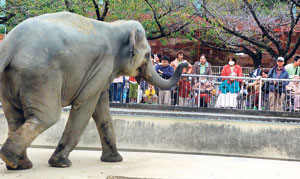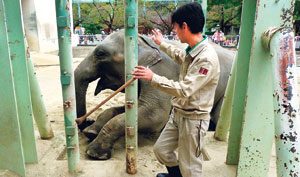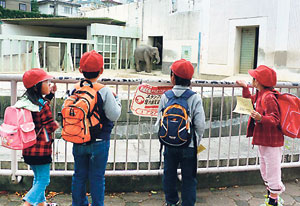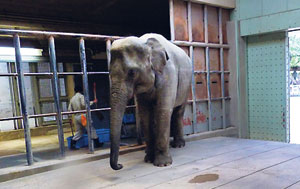I had a date at Nagoya’s Higashiyama Zoo and I was late. The Chief Veterinarian of Higashiyama Zoo was waiting and he accompanied me to meet my Sri Lankan friends - Kosala and Anula. A group of Japanese pre-school children were already greeting the elephants, while some young artists were making replicas of the elephants out of clay as their assignments.
“Kosala and Anula have become a key attraction of our zoo,” said the Director of Higashiyama Zoo, Hiroshi Kobayashi. Kosala and Anula were brought to the Nagoya Zoo in 2007 in exchange for a pair of Black Rhinos and since then have been sharing the Asian Elephant enclosure. The Japanese zoo is proud to be custodians of these Asian Elephants.
 |
| Anula greeting the Japanese crowd |
 |
| Obediant Kosala |
Hiroshi led me to their elephant shed through the backdoor. It is not an open enclosure like in Sri Lanka but as Japan’s winter starts from November, the elephants need to be provided warmth. However, both Kosala and Anula seem to enjoy the snow during the short period they are allowed outside.
“They like to play with the snow like children,” said Hiroshi laughing. The elephant shed is heated and the elephants are well protected during this time, assure the zoo officials. Being larger animals, both the Asian and African elephants seem to be able to adapt to the changing climate and do not show any particular uneasiness in facing the cold.
The elephant shed in fact took me back to the Japanese children’s film “The Little Elephant” I watched when I was a child. The elephant shed which was the original one built at the zoo’s inception looks identical to the one in the film and I wondered whether the story of the famous film too is set in this very zoo.
It was set in World War II where the military try to kill the elephants upon an order to get rid of dangerous animals and the attempt by the elephant keeper and Japanese kids to save their little elephant. In fact during World War II, the Japanese military had received orders to kill some dangerous animals fearing they would escape during the bombings. “But Nagoya Zoo is special as none of their elephants were harmed,” revealed director Hiroshi.
The Japanese government requisitioned Nagoya Zoo for military purposes during the World War and many animals died but the two elephants were able to survive through the efforts of the zoo staff. In 1945, Higashiyama zoo served as a major recreation facility in war-ravaged Japan and the surviving elephants, Makany and Held gave hope to children and boosted the popularity of the zoo. So the Nagoya Zoo considers elephants special.
“That is why we are especially proud to have both Kosala and Anula and grateful to Sri Lanka for sending these elephants,” said director Hiroshi. “Sri Lanka is negotiating to get down a Sea Lion from Higashiyama zoo and despite loads of requests from other zoos, we favour Sri Lanka because of the elephants the Colombo Zoo sent us,” he said.
Anula and Kosala are indeed special, as they can also now understand three languages said the animal keeper through a translator. They still understand the commands they’ve been taught in Sri Lanka - ‘ali bashawa’, but also know some commands in English and in Japanese. Two Sri Lankan mahouts stayed with the elephants during their first few months in Japan and helped the Japanese mahouts get used to the animals.
 |
| Anula - beloved friend of Japanese
children |
 |
| The enclosure that keeps elephants warm during winter |
The elephants are given different kinds of grass and some fresh plants as fodder. During the winter, it is not easy to find food from Japan, but the zoo imports grass cubes from America to feed the elephants.
The keepers showed us banana plants and fresh leaves similar to our Jak that grows in Japan. Both Kosala and Anula who were about 1 tonne at the time they were shipped from Sri Lanka now weigh about 2 tonnes and look healthy.
Higashiyama Zoo in Nagoya was established in 1937 – one year after Sri Lanka’s Dehiwala Zoo opened. It now houses over 500 animals ranging from koala bears and gorillas to polar bears.
The Nagoya zoo is renovating its premises to make the zoo a bridge between humans and nature. Their plan is to make social animals that usually live in a group to actually form groups, and make the exhibition area as similar to their natural habitat as possible.
According to this new plan, both Anula and Kosala will get a new enclosure five times as big as the present one. The Zoo is also adjacent to a Botanical Garden and recreational facilities, so visitors get a total experience.
Zoos’ contribution to conservation
Zoos are not only animal exhibit centres, but also contribute in protecting biodiversity. The Higashiyama Zoo in Nagoya breeds and conserves at least 50 endangered species such as Western Lowland Gorilla, Orangutans, Great Indian Rhinoceros and the Snow Leopard. The Higashiyama Zoo is also the studbook keeper for Koalas and Orangutans in Japan where they keep the pedigree of individual animals to avoid inbreeding.
Most modern zoos and aquariums today are attempting to move toward conservation efforts. The World Association of Zoos and Aquariums (WAZA) presenting their strategic plan at the UN Summit of Biodiversity – COP10 held last month in Japan revealed some practical examples where zoos had helped in the recovery of many species such as the American Condor, Przewalski’s Horse etc.
They are bred and released to the wild. However this is not easy as releasing an animal to the wild needs to be done after careful assessment. If adverse conditions prevail, even the released animals can face the same fate as their doomed cousins.
But Gerald Dick, the president of WAZA - a global organization which unifies the principles and practices of over 1,000 zoos and aquariums – highlights that some species only survive in captivity in zoos.
“Over 600 million visitors annually come through the gates of the world’s zoos and aquariums. So zoos also have a great opportunity to promote environmental education, raise awareness on the need for wildlife conservation,” said Mark Penning – the President WAZA addressing the COP10 side event.
There are two more zoos being built in Sri Lanka – one in Pinnawala and the other in Ridiyagama, so Sri Lanka also has a good opportunity to rethink its role in conservation. |





